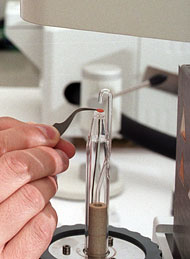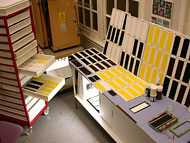A Study of the Physical Characterization of Modern Paints

|
|
The way in which paint films respond to fluctuations of temperature and relative humidity in their environment is governed by their physical properties. Synthetic paint media may expand, soften, and even become sticky upon heating and, conversely, turn extremely brittle at lower temperatures. Such changes in the physical properties of paints may strongly influence phenomena such as surface texture, color, gloss, rates of soiling, and development of cracking. Changes are probably also affected by the presence and nature of pigments and diluting agents, exposure to light, and the age of the material.
Unfortunately, these properties can often be very hard to measure and quantify, as very slight variations in sample preparation or environmental conditions can dramatically alter the behaviour of a paint. In Component Two, methods for measuring these properties are being investigated with three types of instrumental techniques: thermal analysis, mechanical analysis, and surface characterization.

|
|
Work Completed
A range of thermal analytical techniques have been employed to study and measure the glass transition temperature (Tg) of acrylic emulsion paints, and how it alters with aging and aqueous cleaning treatments. Differential Scanning Calorimetry (DSC) has shown much potential in detecting the Tg of acrylic paints and the melting point of surfactant that crystallizes on the paint's surface. However, Dynamic Mechanical Analysis (DMA) has been far more extensively used to determine a broader range of thermal properties
Mechanical testing has built on earlier work by Mecklenburg et al. to quantify the bulk properties of acrylic paints and how they alter with paint formulation, temperature, and relative humidity levels and the rate of changes in those environmental factors.
Surface characterization has relied heavily on Atomic Force Microscopy (AFM), which has enabled some very clear imaging of acrylic paint surfaces, and how they change with cleaning treatments. AFM has been particularly successful at visualizing the migration of surfactant to the surface of acrylic paints and its subsequent removal if aqueous cleaning treatments are used.

|
|
Work in Progress
The current focus of work in this area of the project is to correlate trends seen in any of the physical properites with the chemistry of those paints, in an attempt to understand why certain changes in properties are occurring. This will largely be carried out by applying chemical testing to the vast collection of modern paints that have been painted out at the Smithsonian Museum Conservation Institute, and on which mechanical testing has already been executed.
Page updated: July 2009
